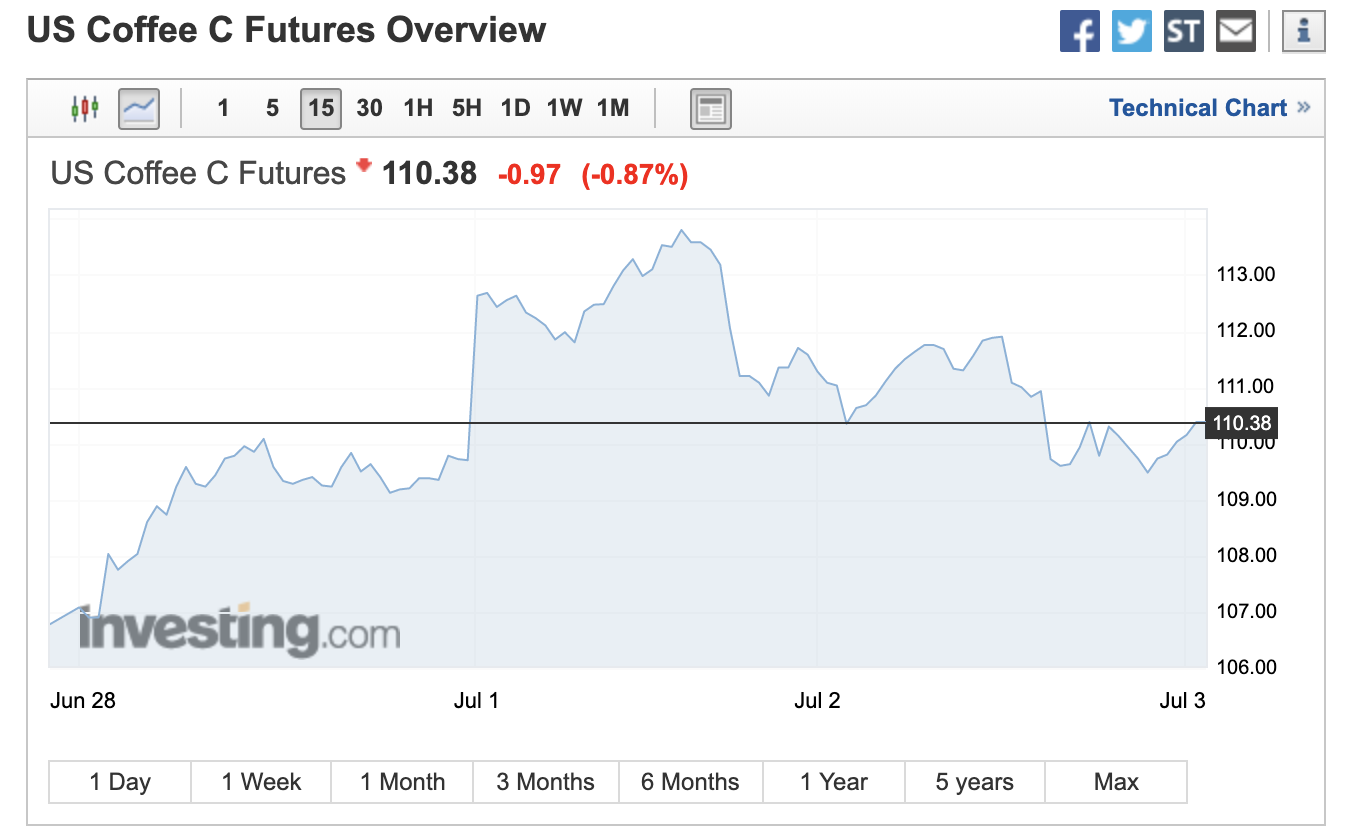C-Market? Whas dat?
Lately in the coffee world, the c-market price for arabica (coffee price determined by NYSE futures market) has been on the lips of more than just traders and buyers. The commodity price for arabica has been held well below the average cost of production for over a year, and it’s a cause for concern for most actors in the supply chain. As I’m just beginning to learn about the mechanisms of the larger coffee market, I have built up a collection of resources that I want to keep handy for my own reference. I also hope to jot down my thoughts here, to keep track of my progress on the subject. My friend Dean Kallivrousis, of Ally Coffee, has been doing some great work on this subject via his Instagram stories, and is the inspiration for this deeper dive into my own education on the subject.
First, I can hear what you’re thinking - “But don’t you deal with with specialty arabica? Doesn’t the specialty market operate above the commodity market? Why do we, specialty people, have to concern ourselves with the commodity coffee market price?” My short answer is: because it matters to the global economy, in which we, specialty people, and the producers we buy from, exist.
The longer answer is a bit more complex. To start, it’s the base price for price negotiation with producers. This sounds good in theory, but in practice “The C” becomes “The Price” when commodity traders buy and sell coffee. It also becomes “The Price” for a lot of buyer-farmer discussions, and at the very least becomes the benchmark to which all price premium considerations are pegged, unfortunately. What was intended as a tool for negotiation has become a restraint for price expectations. Rather than letting the “free market” and production realities regulate pricing, we’ve forced producers and buyers into this model of servitude to the NYSE, with prices determined by futures traders who couldn’t even point out a coffee tree in a lineup.
Most of the specialty coffee buyers I know operate on a very small scale, and are less beholden to the C-price structures. They enter into negotiations based on other factors, such as cost of production, previous harvest price agreements, and quality bonuses. The fine people at Junior’s Roasted Coffee have been active in sharing their purchasing methods with the specialty coffee community via a series of events and lectures called “The Cost of Production Project.”
On the scale of the larger coffee industry, these buyers are not common and are operating in ways that would never work for those buying dozens of containers of coffee per year. A 10-cent difference in price could mean tens of thousands of dollars, and is the difference between a healthy and a scant profit margin. So it’s understandable that average buyers aren’t interested in changing the pricing paradigm. It works for them, so there’s no incentive to challenge the status quo.
And to add another variable - since the C Price is in USD, growers are highly susceptible to exchange rates as well. Depending on the given country’s currency, its relationship to the dollar can add another challenge.
But wait a second, what is a commodity anyway? According to Wikipedia, “a commodity is an economic good or service that has full or substantial fungibility.” The market treats all commodity goods in a category the same. As long as it has passed the basic binary quality measures (yes/no or pass/fail), it is worth the same as its neighbor. “The wide availability of commodities typically leads to smaller profit margins and diminishes the importance of factors other than price.” To oversimplify: if there’s a lot of something, it’s a commodity. If there’s just a little bit of it, it’s “specialty.”
The commodity market generates coffee pricing based on multiple factors, primarily supply, demand, and speculation about supply and demand. As with other commodities, the quality of the coffee is a minor consideration, with binary (pass/fail) “quality” standards similar to those for other commodities (wheat, corn, soy). The commodity market then adjusts the price depending on supply, demand, and speculation. The way the market is organized now, it excels at producing large volumes of low-cost, “passable” quality coffee. Small quantities of specialty quality coffee represent barely 1% of the total volume of coffee, so we’re likely to see the end of capitalism itself or the collapse of climate-ravaged agriculture while we wait for the greater market to be influenced by the “specialty coffee revolution” in any significant way. A significant, sustainable change to the way we price coffee will require an industry-wide (paging Nestle & JAB), sustained, and organized response in order to have any real effect felt by the average smallholder grower.
For those of us concerned with the larger effects of commodity market pricing, here’s a good read on Coffee and Migration, and the C-market’s role in the US-Central America immigrant crisis, from The Independent. According to this article, Guatemalan farmers must receive at least $1.93 per pound just to cover their production costs. This doesn’t include things such as feeding their families, paying for school, or any such quality of life costs. Many are giving up on coffee.
Gustavo Alfaro, who sells coffee to Starbucks and several other American speciality companies, says half of his workforce has migrated in the past year alone.
Most of those employees are seasonal, balancing work on their own small farms with work on Alfaro’s larger finca. Their own farms are almost worthless. “I can’t convince them to stay,” Alfaro says. “They have it in their heads now that coffee is dead. They’ve given up on it.”
Those who are wealthy enough to be large land holders, with expansive coffee growing estates, can afford to make calculated, risky decisions, and can survive even if they only make a few cents margin on each pound they sell as a result of the huge volumes they can produce. Finding consistent labor becomes their main challenge. Smallholder farmers, who make up the vast majority of coffee producers, can’t achieve the economies of scale that would help them stay in the game. As most buyers are beholden to the C-market price rather than cost of production or true negotiation, smallholders must decide every year whether to continue growing coffee, on the hopes of a market rebound. Due to this year’s global production glut, though, a rebound is highly unlikely, and we are bound to hear more stories about farmers opting for more profitable crops as the year moves on. And since companies that finance coffee purchases must operate with guarantees that the majority of smallholders can’t make, loans are neither a reliable nor a safe option. Even if they do manage to sell all of their coffee, paying back the loans becomes a challenge in itself given the always-moving C price (which may come below the price at which the crop was financed). Also, many of these loans simply aren’t available given the size of the smallholder’s enterprise.
There’s a lot to unpack, and tons to learn. This is just the beginning of my own education about coffee pricing mechanisms, so keep an eye here for more as I go ever deeper into this territory. Do you have any insights or opinions? Am I going about this all wrong? I’m all ears at this point.
View up-to-the-minute C-market activity (investing.com).


